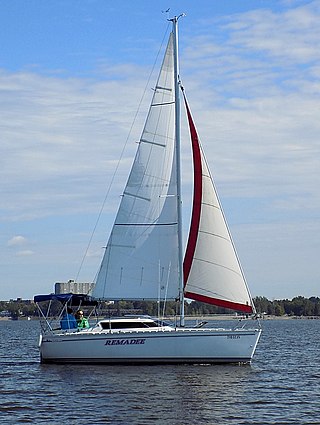Related Research Articles

The Tonic 23 is a French trailerable sailboat, that was designed by Philippe Harlé as a coastal cruiser and first built in 1985.
The Cape Cod Cat, also called the Cape Cod Cat 17 and the Hermann Cat, is an American trailerable sailboat that was designed by Charles Whittholz as a day sailer/cruiser and first built in 1968.
The Alerion Express 19 is an American trailerable sailboat that was designed by Gary Hoyt as a cruiser and first built in 1998.
The Com-Pac Horizon Cat, also called the Horizon Cat 20, is an American trailerable sailboat that was designed by Halsey Herreshoff as cruiser and first built in 2002.
The Com-Pac Sun Cat, also called the Com-Pac Sun Cat 17, is an American trailerable sailboat that was designed by Clark Mills as a pocket cruiser and first built in 2000.
The Elite 25, also called the Feeling 720 NV, is a French trailerable sailboat that was designed by Michel Joubert of Joubert-Nivelt as a cruiser and first built in 1982.
The Hermann 22, also called the Hermann 20 for its waterline length, is an American trailerable sailboat that was designed by Richard P. Ketcham Jr. as a cruiser and first built in 1961.
The Herreshoff America, also called the Herreshoff America 18, is an American trailerable sailboat that was designed by Halsey Chase Herreshoff as a cruiser and first built in 1971.
The Lynx 16 is an American trailerable sailboat that was designed by Tony Davis as an daysailer and pocket cruiser, and first built in 1997.
The Sanderling 18, also called the 18' Sanderling, Marshall Sanderling and just the Sanderling, is an American trailerable sailboat that was designed by Breckenridge Marshall as a daysailer and cruiser and first built in 1962. It is named for the shore bird.
The Menger Cat 17 is an American trailerable sailboat that was designed by Andrew Menger as a daysailer and cruiser and first built in 1983.
The Menger Cat 23, also called the Thom Cat 23. is an American trailerable sailboat that was designed by Bill and Andrew Menger, based on the work of Francis Sweisguth. It was intended as daysailer and cruiser and first built in 1990.
The Menger Oysterman 23 is an American trailerable skipjack that was designed by Bill Menger as a daysailer and cruiser and first built in 1977.
Menger Boatworks was an American boat builder based in Babylon, New York on Long Island. The company specialized in the design and manufacture of fiberglass sailboats, particularly catboats and character boats.
The Menger Cat 15, also called the Menger Cat Daysailer and the Thom Cat 15 Daysailer, is an American sailing dinghy that was designed by Bill Menger and Andrew Menger as a daysailer and first built in 2001.
The Mystic Catboat 20 is an American trailerable sailboat that was designed by Peter Legnos as a cruiser and first built in 1974.
The O'Day 26 is an American trailerable sailboat that was designed by C. Raymond Hunt and Associates as a cruiser and first built in 1983.
The Pearson 23 is an American trailerable sailboat that was designed by William Shaw as a cruiser and first built in 1978.
The Mustang 22 is an American trailerable sailboat that was designed by Martin Bludworth as a Midget Ocean Racing Club racer and first built in 1969.
The Seaward 23 is an American trailerable sailboat that was designed by Nick Hake as a pocket cruiser and first built in 1984.
References
- 1 2 3 4 5 6 7 8 McArthur, Bruce (2020). "Menger Cat 19 sailboat". sailboatdata.com. Archived from the original on 1 August 2021. Retrieved 1 August 2021.
- 1 2 3 4 5 6 7 8 9 10 Henkel, Steve: The Sailor's Book of Small Cruising Sailboats, page 43. International Marine/McGraw-Hill, 2010. ISBN 978-0-07-163652-0
- ↑ McArthur, Bruce (2020). "Menger Cat 17 sailboat". sailboatdata.com. Archived from the original on 29 July 2021. Retrieved 30 July 2021.
- ↑ McArthur, Bruce (2021). "Menger Boatworks (USA) 1976 - 2004". sailboatdata.com. Archived from the original on 29 July 2021. Retrieved 1 August 2021.
- ↑ Thompson Boatworks (16 June 2010). "Thom Cat 19". thompsonboatworks.com. Archived from the original on 1 August 2021. Retrieved 1 August 2021.
- ↑ Perry, Bob (15 August 2021). "Perry Design Review: Menger 15 and 19". boats.com. Archived from the original on 18 June 2018. Retrieved 5 August 2021.